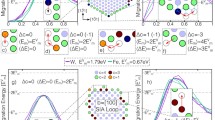Abstract
Dislocation configurations are shown to develop in nickel single crystals as a result of diffusion of carbon from a vapor source. Since carbon is dissolved interstitially in nickel, the presence of such dislocation configurations demonstrates that lattice parameter changes suffice for generating dislocation arrays and that the vacancy requirements involved in diffusion of substitutionally dissolved atoms are nonessential. In particular, carbon was diffused for 30 min at 1000°C into the (111) surfaces of thick nickel crystals, and the resulting dislocation arrangements in the diffusion zone were examined by etch pitting (111) sections. The dislocation density increases from the “grown-in” 1.5 x 106 per cm2 so that in some regions near that surface it is about 107 per cm2. At least half of all the dislocations appear to be arrayed in subgrain boundaries in these sections. The dislocation density decreases towards the interior until at about 3.5√Dte (√Dt e= 210 μm) it approximates the “grown-in” dislocation density, but even at distances exceeding 0.7√Dte there still exist locally high density regions. These have a regular geometry in which dislocations appear to be on (•111), (1•11) or (11•1) slip planes. The subgrain size is 36 μm near the as-diffused surface and increases, until at 3.5√Dte, it is 160 μm, which is the average subgrain size in the undiffused crystal.
Similar content being viewed by others
References
for example: E. Levine, J. Washburn, and G. Thomas:J. Appl. Phys., 1967, vol. 38, pp. 81–87 and 88-95; S. Prussin:J. Appl. Phys., 1961, vol. 32, pp. 1876-81 ; J. W. Matthews, S. Modes, and T. B. Light:J. Appl. Phys., 1970, vol. 41, pp. 3800-04.
V. Y. Doo and R. W. Balluffi:Acta Met, 1958, vol. 6, pp. 428–38.
P. S. Ayres and P. G. Winchell:J. Appl. Phys., 1968, vol. 39, pp. 4820–23; andJ. Appl. Phys., 1972, vol. 43, pp. 816-20.
P. G. Winchell, John Boah, and P. S. Ayres:J Appl. Phys., 1971, vol. 42, pp. 2612–18.
J. K. Boah:Met. Trans., 1973, vol. 4, pp. 1432–33.
L. S. Darken and R. W. Gurry:Physical Chemistry of Metals, p. 443, McGraw-Hill, New York, 1953.
R. P. Smith:Trans. TMS-AIME, 1966, vol. 236, pp. 1224–27.
Jun-ichi Echigoya, Shigeyuki Hayashi, and Mikio Yamamoto:Jap. J. Appl. Phys., 1969, vol. 8, p. 964.
J. K. Boah and P. G. Winchell:J. Appl. Phys., 1974, vol. 45, pp. 1476–77.
C. S. Barrett:Structure of Metals, 1st ed., p. 587, McGraw-Hill, New York, 1948.
J. Weertman and J. R. Weertman:Physical Metallurgy, 2nd ed., R. W. Cahn, ed., p. 924, North Holland Publishing Co., London, 1970.
K. Hirano, R. P. Agarwala, B. L. Averbach, and M. Cohen:J. Appl. Phys., 1962, vol. 33, pp. 3049–54.
J. M. Blakely and H. Mykura:Acta Met., 1961, vol. 9, pp. 23–31.
C. J. Smithells:Metals Reference Book, vol. 2, 3rd ed., p. 614, Butterworths, London,1962.
L. Zwell, E. J. Fasiska, and A. S. Keh:Trans. TMS-AIME, 1968, vol. 242, pp. 765–66.
P. Haasen:Phil. Mag., 1958, vol. 3, pp. 384–418.
Landolt-Bornstein Tables, New Series III/1, p. 22, Springer-Verlag, New York, 1966.
Author information
Authors and Affiliations
Rights and permissions
About this article
Cite this article
Boah, J.K., Winchell, P.G. Dislocation configurations developed during carburization of nickel. Metall Trans A 6, 717–724 (1975). https://doi.org/10.1007/BF02672291
Received:
Issue Date:
DOI: https://doi.org/10.1007/BF02672291



